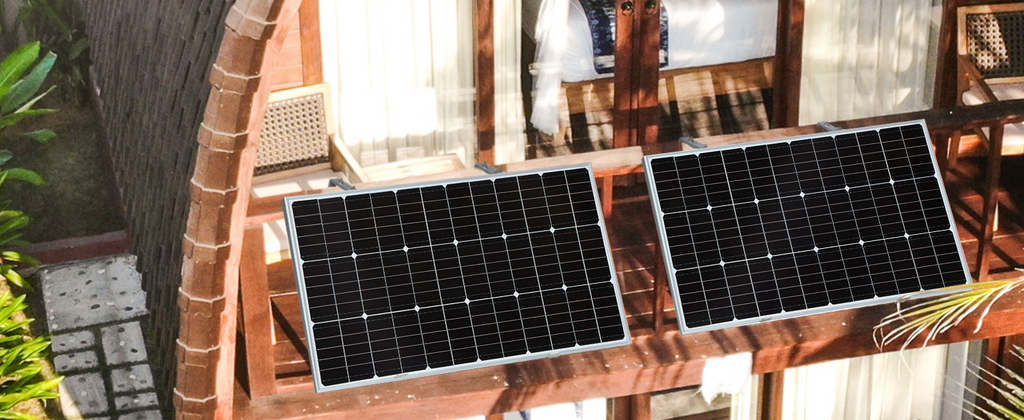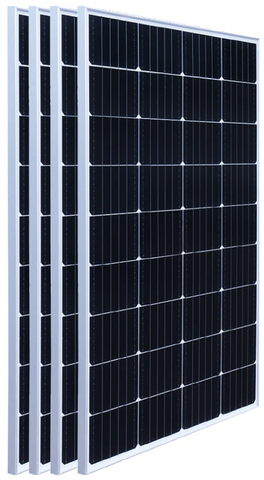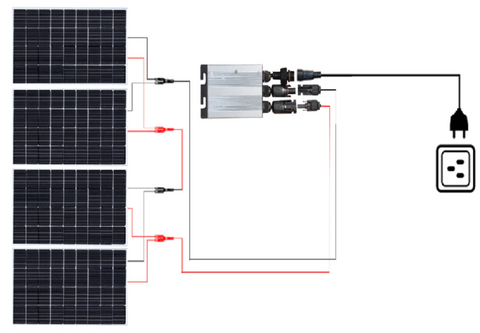
Was ist ein Balkonkraftwerk?
Angesichts des weltweit steigenden Energiebedarfs wird Solarenergie für Hausbesitzer immer beliebter. Ob um kurzfristige Preissteigerungen auszugleichen oder die Abhängigkeit von fossilen Brennstoffen langfristig zu verringern – Solarenergie ist eine praktikable und zunehmend erschwingliche Option für viele Menschen, die ihre Energiekosten besser im Griff haben möchten.
Die meisten Menschen glauben, man bräuchte ein komplett mit Solarmodulen bedecktes Dach, um die Vorteile der Solarenergie zu nutzen. Das stimmt aber nicht immer. Kleine Solaranlagen für Privathaushalte können Hausbesitzer teilweise oder sogar vollständig mit Energie versorgen und sind in verschiedenen Ausführungen für jedes Budget erhältlich, beispielsweise als Balkon-Solaranlage .
Eine Solaranlage auf dem Balkon liefert genügend Strom für Ihren Laptop und Ihre Beleuchtung.
Mit einer solchen Solaranlage zum Einstecken können Sie Strom erzeugen, um Ihren Computer im Homeoffice zu betreiben, den Akku Ihres E-Bikes aufzuladen oder das Licht einzuschalten. Experten schätzen, dass eine solche Anlage bis zu 15 Prozent Ihres Strombedarfs decken kann. Die aus Sonnenenergie erzeugte Energie reicht jedoch nicht aus, um den Geschirrspüler zu betreiben oder Nudeln zu kochen. Haushaltsgeräte benötigen deutlich mehr Strom. Dasselbe gilt übrigens auch für einen Tesla. Er benötigt mindestens fünfmal so viel Energie, bevor die Ladebuchse überhaupt leuchtet.
Was ist eine Balkon - Solaranlage ?
Balkon-Solaranlagen sind eine Art von Solarenergiesystem, das für die Installation auf Balkonen oder Dächern konzipiert ist. Diese Systeme bestehen typischerweise aus Solarmodulen, einem Wechselrichter oder Mikro-Wechselrichter und manchmal auch einem Akku. Die Solarmodule wandeln Sonnenlicht in Strom um und speichern diesen im Akku, der dann zur Stromversorgung Ihres Hauses genutzt wird. In manchen Fällen kann der vom Mikro-Wechselrichter erzeugte Überschussstrom in das öffentliche Stromnetz eingespeist werden.
Im Allgemeinen sind diese Systeme – insbesondere die mit Mikro-Wechselrichter ausgestatteten – einfach einzurichten und zu warten und bieten eine zuverlässige Energiequelle mit minimalen Umweltauswirkungen.
Was umfasst eine Balkon-Solaranlage?
1: Solarmodule : Solarmodule sind die Hauptkomponente einer Balkon-Solaranlage . Sie bestehen aus Photovoltaikzellen, die Sonnenlicht in Strom umwandeln. Die Größe und Anzahl der benötigten Module hängt von der gewünschten Strommenge und der Balkongröße ab. Shenzhen Solarparts bietet Balkon-Solaranlagen mit 300 W, 600 W, 800 W und 900 W an, die sich derzeit großer Beliebtheit auf dem EU-Markt erfreuen.
2: Wechselrichter: Der Wechselrichter ist ein Mikro-Wechselrichter, der den von den Solarmodulen erzeugten Gleichstrom (DC) in Wechselstrom (AC) umwandelt. Dieser Wechselstrom kann zum Betrieb Ihrer Haushaltsgeräte verwendet werden. Er kann direkt an Ihre Haushaltssteckdose angeschlossen werden.
3: Montagehalterungen : Die Montagehalterungen dienen zur Befestigung der Solarmodule am Balkon. Sie müssen ausreichend stabil sein, um das Gewicht der Module zu tragen und Wind sowie anderen Umwelteinflüssen standzuhalten.
4: PV- Kabel : Kabel dienen der Verbindung der Systemkomponenten und der Integration des Systems in das elektrische Netz des Gebäudes. Art und Größe der benötigten Kabel hängen von der Größe und Konfiguration Ihres Systems ab.
Wie funktioniert eine Solaranlage auf dem Balkon?
- Sonnenlicht trifft auf die Solarzellen und wird in Elektrizität umgewandelt.
- Der Laderegler steuert den Stromfluss von den Solarmodulen zum Batteriespeicher.
- Der Wechselrichter wandelt den Gleichstrom in Wechselstrom um.
- Der Wechselstrom wird zur Stromversorgung Ihrer Haushaltsgeräte und -geräte verwendet.
Was sind die Vorteile einer Solaranlage auf dem Balkon ?
- Umweltfreundlich : Eine Solaranlage auf dem Balkon erzeugt Strom aus einer erneuerbaren Energiequelle, der Sonne. Dadurch verringern Sie Ihre Abhängigkeit von fossilen Brennstoffen und tragen zur Reduzierung von Treibhausgasemissionen bei.
- Kosteneinsparungen : Durch die Erzeugung Ihres eigenen Stroms können Sie Ihre Energiekosten senken und langfristig möglicherweise Geld sparen.
- Erhöhte Energieunabhängigkeit : Mit einer Solaranlage auf dem Balkon sind Sie weniger vom Stromnetz abhängig und können Ihren eigenen Strom erzeugen, auch bei Stromausfällen.
- Energieunabhängigkeit : Eine kleine, modulare Solaranlage auf dem Balkon trägt dazu bei, dass Ihr Haushalt unabhängiger vom Stromnetz wird. Das bedeutet, dass Sie in Zeiten hoher Energiepreise oder Notfällen über eine zuverlässige Stromquelle verfügen, um Ihr Zuhause mit Strom zu versorgen, und dass Sie den Strombezug aus dem Netz reduzieren und so Kosten sparen können.
- Einfache Installation : Dank der einfachen Plug-and-Play-Installation sind Balkon-Solaranlagen kompakt und leicht zu installieren – ideal für Wohnungen und Büros mit begrenztem Platzangebot. Keine Meldepflicht (in Deutschland und Österreich) : Solange Ihre Balkon-Solaranlage eine bestimmte Leistung nicht überschreitet (maximal 600 W in Deutschland und 800 W in Österreich), müssen Sie sie nicht bei Ihrem Energieversorger oder der zuständigen Behörde anmelden. Das macht die Installation schnell und unkompliziert und erspart Ihnen unnötigen Papierkram, Bürokratie und Wartezeiten.
Um mehr über die photovoltaische Stromerzeugung zu erfahren, besuchen Sie bitte die offizielle Website von XINPUGUANG :
Facebook: Xinpuguang Solar Panel Instagram: xinpuguangsolar
Pinterest: XinpuguangSolarPanels
Homepage: https://xinpuguangsolar.com
- Die Auswahl einer Auswahl führt zu einer vollständigen Seitenaktualisierung.




